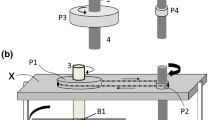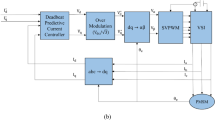Abstract
Highly dynamic induction motor drives require converter-driven low-inertia induction machines, which are continuously operated with high torque dynamics to accelerate and brake linear or rotating masses in a highly dynamic manner. However, every rapid change in the torque requires a correspondingly rapid change in the rotor current, which leads to the excitation of the transient skin effect in the massive rotor bars of squirrel cage motors. The additional eddy current losses resulting from the transient skin effect can cause overheating problems, especially in the case of deep rotor bars with fast load cycles. This paper is intended to show the reader how the additional rotor losses caused by the transient skin effect can be reduced through the design optimization procedure. At the same time, the other operating characteristics of the induction motor drive are not impaired. In addition, the moment of inertia of the drive motor can also be reduced as another optimization target by the multi-objective optimization process. As the underlying optimization algorithm, the differential evolution and the particle swarm optimization are implemented and compared with each other in order to verify the correctness of the optimization results. During the whole optimization work, great importance is attached to the interdisciplinary calculation method so that the interaction between the electromagnetic, thermal, fluid mechanical and control engineering processes can be taken into account through the coupled calculation. In the end, the theoretical and simulative findings are verified with two test benches.










Similar content being viewed by others
References
Quang NP, Dittrich J (2015) Vector control of three-phase AC machines, 2nd edn. Springer-Verlag, Berlin
Köhring P (2009) Beitrag zur Berechnung der Stromverdrängung in Niederspannungsasynchronmaschinen mit Kurzschlussläufern mittlerer bis großer Leistung (Contribution to the calculation of the skin effect in low-voltage squirrel-cage induction motors of middle and high power range), Dissertation, Universität Bergakademie Freiberg
Zhang Y, Hofmann W (2018) Determination of transient eddy current losses in induction motors with high torque dynamics. In: IECON 2018—44th annual conference of the IEEE industrial electronics society, Washington, DC, USA, pp 477–482. https://doi.org/10.1109/IECON.2018.8591693
Köhring P (2009) Closed solution of the transient skin effect in induction machines. Electr Eng 91(9):263–272. https://doi.org/10.1007/s00202-009-0136-8
Zhang Y, Hofmann W (2013) Energy-efficient control of induction motors with high torque dynamics and transient skin effect. In: IECON 2013—39th annual conference of the IEEE industrial electronics society, Vienna, Austria, pp 2774–2779. https://doi.org/10.1109/IECON.2013.6699570
Zhang Y, Peng H, Hofmann W (2019) Load cycle-based design optimization of induction motor drives for highly dynamic applications. In: IEEE international conference on industrial technology (ICIT) 2019, pp 286–291.https://doi.org/10.1109/ICIT.2019.8754948
Juha P, Tapani J, Valéria H (2014) Design of rotating electrical machines, 2nd edn. John Wiley & Sons, New York
Jokinen T, Saari J (1997) Modelling of the coolant flow with heat flow controlled temperature sources in thermal networks. IEE Proc - Electr Power Appl 144(5):338–342
Sakthivel V, Bhuvaneswari R, Subramanian S (2010) Economic design of three-phase induction motor by particle swarm optimization. J Electromagn Anal Appl 2(5):301–310. https://doi.org/10.4236/jemaa.2010.25039
Das S, Suganthan PN (2011) Differential evolution: a survey of the state-of-the-art. IEEE Trans Evol Comput 15(1):4–31. https://doi.org/10.1109/TEVC.2010.2059031
Abbas Q, Ahmad J, Jabeen H (2015) A novel tournament selection based differential evolution variant for continuous optimization problems. Math Probl Eng 2015:1–21. https://doi.org/10.1155/2015/205709
Brest J, Greiner S, Boskovic B, Mernik M, Zumer V (2006) Self-adapting control parameters in differential evolution: a comparative study on numerical benchmark problems. IEEE Trans Evol Comput 10(6):646–657. https://doi.org/10.1109/TEVC.2006.872133
Yasodha S, Ramesh K, Ponmurugan P (2012) Evolutionary multiobjective optimization algorithms for induction motor design—a study. Int J Emerg Technol Adv Eng 2:627–633
Zitzler E, Thiele L (1999) Multiobjective evolutionary algorithms: a comparative case study and the strength Pareto approach. IEEE Trans Evol Comput 3(4):257–271. https://doi.org/10.1109/4235.797969
Köppen M, Yoshida K (2007) Substitute distance assignments in NSGA-II for handling many-objective optimization problems. In: Evolutionary multi-criterion optimization: 4th international conference, pp 727–741. https://doi.org/10.1007/978-3-540-70928-2_55
Acknowledgements
The authors thank the German Research Foundation (DFG) for funding this project (Project-No. HO 1483/60 1-3).
Author information
Authors and Affiliations
Corresponding author
Additional information
Publisher's Note
Springer Nature remains neutral with regard to jurisdictional claims in published maps and institutional affiliations.
Rights and permissions
Springer Nature or its licensor (e.g. a society or other partner) holds exclusive rights to this article under a publishing agreement with the author(s) or other rightsholder(s); author self-archiving of the accepted manuscript version of this article is solely governed by the terms of such publishing agreement and applicable law.
About this article
Cite this article
Zhang, Y., Peng, H. & Hofmann, W. Transient skin effect in highly dynamic induction motor drives: energy-optimized design. Electr Eng 105, 1015–1024 (2023). https://doi.org/10.1007/s00202-022-01712-3
Received:
Accepted:
Published:
Issue Date:
DOI: https://doi.org/10.1007/s00202-022-01712-3




